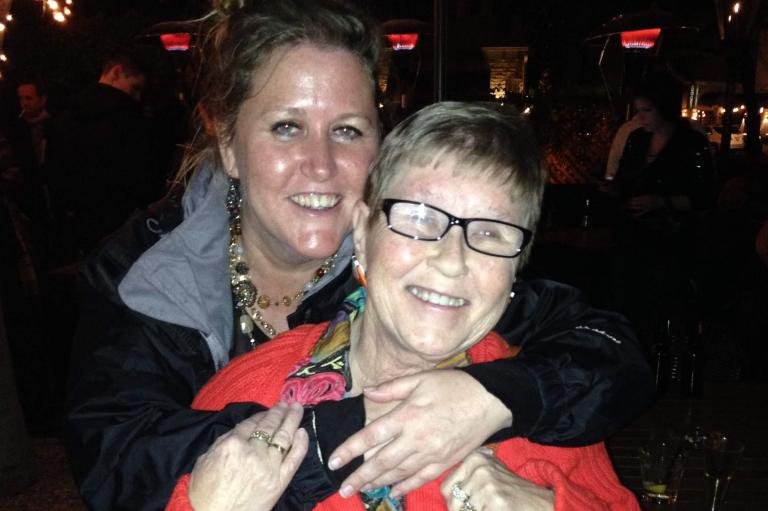1 of 5 | Kelly Kalkofen (L) says Alzheimer's disease changed her mother, Patty Slater, and the family struggled to care for her. Photo courtesy of Kelly Kalkofen
Sept. 29 (UPI) -- Tucked into the largest congressional spending package in a generation is an infusion of cash for home healthcare services, which advocates say are chronically underfunded despite a growing need.
The multitrillion-dollar package being debated in Congress includes $190 billion to shift care for seniors and disabled people away from hospitals and long-term care facilities to home and community settings.
The social spending bill is at the center of President Joe Biden's promise to invest in "human capital" along with roads, bridges and other traditional infrastructure. The funding would boost sagging wages and meager training for home healthcare workers who are increasingly in demand.
"The pandemic has exposed the cracks in the system when it comes to supporting people in the long term," said Nicole Jorwic, senior director of public policy for national disability advocacy group The Arc. "We have over-relied on nursing homes. This would go a long way in creating the capacity we need in the system."
The bill would help make up for decades of underfunding for Medicaid. It'll also address Medicaid's "institutional bias," which requires nursing homes to be covered but not home care, she said.
The provision has drawn criticism in Congress, primarily from Republicans who say it centralizes too much control of Medicaid in the federal government while giving states less flexibility.
"We are doing a seismic overhaul of Medicaid that will upend the program as we know it," U.S. Rep. Buddy Carter, R-Ga., said during a committee hearing earlier this month.
During the hearing, Republicans said only states that can meet the additional requirements can access the money, making the benefits uneven. U.S. Rep. Kurt Schrader, D-Ore., also criticized it for short-changing assisted-living facilities.
Growing demand
But Jorwic said home-based services are less costly and demand is high. Nearly 820,000 people nationally are on waiting lists for home and community-based services funded by Medicaid. One study found that home-based services cost half of nursing homes, which charge $90,000 to $100,000 a year.
By 2030, every member of the Baby Boomer generation will be 65, and nearly 70% will need some sort of long-term care or service.
Despite the demand, home healthcare workers remain poorly paid, with a median annual income of just $13,000, according to Service Employees International Union, which represents many of these employees. The home healthcare workforce is also overwhelmingly female at 89%, according to the union. Nearly half of workers live in households that receive public assistance.
"This was a workforce that was in crisis before the pandemic," Jorwic said. It's gotten worse with the country's tight labor market.
These dynamics spell a more difficult situation for people like Denny Slater.
Struggle for care
Slater, a retired police officer, became a full-time caregiver for his wife, Patty, in 2015 as the Alzheimer's disease she was diagnosed with in her early 60s worsened.
He recalled how his wife started to forget where he was while working at a seasonal job preparing tax returns. He'd leave notes reminding her, but she started overlooking those. He had to leave his office between clients to check on her. He got a call from Scottsdale, Ariz., police after she wandered off. Finally, he became her full-time caregiver, and the couple moved to Salem, Ore.
Kelly Kalkofen, the couple's daughter, recalled how her mother's whole personality changed and how she became agitated by not being able to feed herself or tie her shoes. Her mother refused medicine, and her father had to sneak the most important ones into her butterscotch pudding, she said.
Her mother would suddenly storm off and needed someone to constantly watch her, but would sometimes get a head start when her husband stepped away to use the bathroom.
"I didn't have any idea how to handle it," said Slater, 75.
He recalled being unable to direct his wife as he followed her during her wandering episodes, which he said lasted about 40 minutes. Sometimes he had to bring her away from freeways or other dangerous areas.
He tried hiring home aides, but they weren't much help. He said they were poorly trained to care for someone with Alzheimer's and would cower when his wife became agitated.
"One time I looked in the mirror, and I didn't recognize myself," Slater said. He hadn't shaved, showered or even combed his hair because all of his attention was focused on caring for his wife, who died in 2020.
Strained system
An earlier iteration of the bill included $400 billion for home and community-based care services. But earlier this month, the House Committee on Energy and Commerce approved a portion of the legislation that reduced the funding for the service to $190 billion.
Jorwic said it should be at least $250 billion. States will need to meet additional requirements to access the money. Less money means fewer states will find it's worth signing on or won't be able to access the money, she said.
The amount in the bill also isn't enough to build capacity in rural areas or improve wages and training for workers, leaving the system strained, she said. But Jorwic remains optimistic funding will be added through the legislative process.
Rachel Conant, vice president of federal affairs for the Alzheimer's Association and the Alzheimer's Impact Movement, said in a statement that the funding will benefit the 6 million Americans living with Alzheimer's disease and their 11 million caregivers.
She said she's also encouraged by bipartisan support for extending the "Money Follows the Person," a federal program that's helped over 101,000 seniors and disabled people move from nursing homes to community settings.















